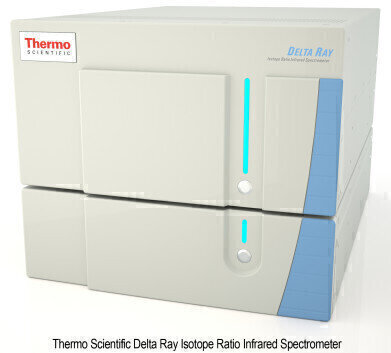Portable & field testing
Isotope Ratio Measurement Can Now Go to the Sample Site
Mar 12 2014
Scientists monitoring greenhouse gases, plant ecology, carbon sequestration, and volcanic emissions, among other CO2 analysis applications, can now transport powerful isotope ratio analysis capability to the sources of samples. This can eliminate the bottleneck of transporting samples from the field to the lab, for potential gains in insight, productivity and cost savings.
The Delta Ray system is a new category of analyser for the continuous measurement of isotope ratio values from CO2 in ambient air. The ability to transport the system into the field can enable scientists to continuously collect data, 24 hours per day, seven days per week. Scientists can measure short duration phenomena that may have previously been missed due to the low-frequency sample acquisition. By comparison, a lab transporting samples from the field might only be able to collect one or two samples per week. In addition to more data, the field-deployable system can reduce or eliminate costs for vials, flasks and transportation.
“Isotope ratio infrared spectroscopy brings a paradigm shift to isotope ratio analysis,” said HJ. Jost, Thermo Fisher product manager for the Delta Ray system. “The potential to expand our current isotope analysis portfolio into field deployable systems, and the excitement of customers once they see the power of continuous measurement at the source, drove our desire to make this technology broadly available.”
“A step forward in the surveillance of volcanoes is now possible,” said Andrea Rizzo, researcher studying Mt. Etna for Istituto Nazionale di Geofisica e Vulcanologia, (INGV), Sezione di Palermo, Italy. “Laser spectroscopy for stable isotope analysis in the field opens new and exciting perspectives for the scientific community, such as the opportunity to perform real-time measurements of elemental and isotope composition of CO2 in volcanic gases.”
INGV-Palermo performs geochemical monitoring of Mt. Etna to evaluate volcanic activity with the goal of predicting eruptions.
The Delta Ray analyser uses laser-based mid-infrared spectroscopy to simultaneously measure carbon13 isotope and oxygen 18 isotope with a precision of better than 0.1 parts per thousand in minutes. The mid-infrared range produces absorption signals about 8,000 times stronger than the near-infrared for superior performance and reduced need to clean the mirrors. The system’s Universal Reference Interface is engineered to automate referencing and calibration for verifiable measurements and high-confidence results. The system is designed to measure large and small-scale changes in atmospheric CO2 at concentrations from 200 ppm to 100% (with optional dilution box) over a wide range of time scales.
The entire system fits the cargo areas of most standard sport utility and other light vehicles, thanks to its small 588 x 424 mm footprint and 37 kg weight. An external computer is not needed.
For more information please visit the website.
Digital Edition
AET 28.4 Oct/Nov 2024
November 2024
Gas Detection - Go from lagging to leading: why investment in gas detection makes sense Air Monitoring - Swirl and vortex meters will aid green hydrogen production - Beyond the Stack: Emi...
View all digital editions
Events
Jan 12 2025 Abu Dhabi, UAE
Jan 14 2025 Abu Dhabi, UAE
Jan 20 2025 San Diego, CA, USA
Carrefour des Gestions Locales de L'eau
Jan 22 2025 Rennes, France
Safety, Health & Wellbeing LIVE
Jan 22 2025 Manchester, UK



















